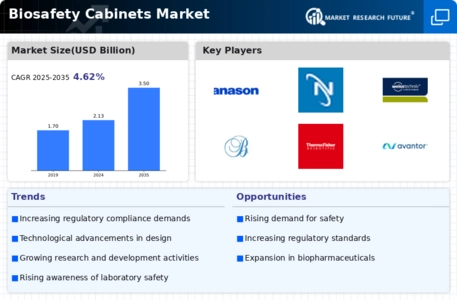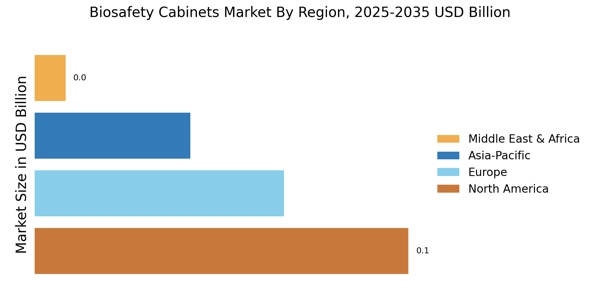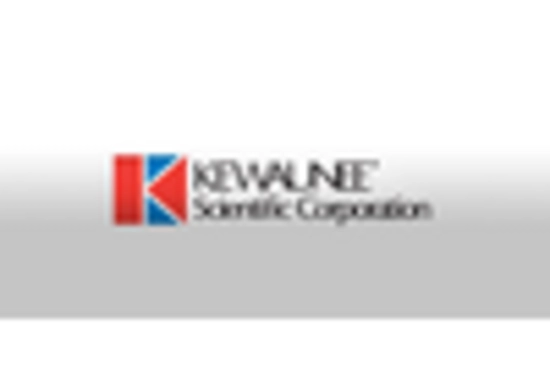Expansion of Biopharmaceutical Research
The expansion of biopharmaceutical research is a significant driver for the Biosafety Cabinets Market. As the biopharmaceutical sector continues to grow, driven by the need for innovative therapies and vaccines, the demand for biosafety cabinets is likely to increase. Research facilities engaged in biopharmaceutical development require stringent safety measures to handle hazardous materials, making biosafety cabinets essential. The biopharmaceutical market is projected to reach a value of over 500 billion dollars by 2025, which suggests a corresponding rise in the need for biosafety cabinets to support this growth. This trend highlights the critical role of biosafety cabinets in facilitating safe research practices within the rapidly evolving biopharmaceutical landscape, thereby bolstering the Biosafety Cabinets Market.
Increased Awareness of Laboratory Safety
The rising awareness regarding laboratory safety protocols is a crucial driver for the Biosafety Cabinets Market. As research institutions and laboratories prioritize the protection of personnel and the environment, the demand for biosafety cabinets is likely to increase. This heightened focus on safety is reflected in the growing number of safety regulations and guidelines established by health organizations. Consequently, laboratories are investing in advanced biosafety cabinets to ensure compliance with these standards. The market for biosafety cabinets is projected to grow at a compound annual growth rate of approximately 6.5%, indicating a robust demand driven by safety concerns. This trend underscores the importance of biosafety cabinets in maintaining a secure working environment, thereby propelling the Biosafety Cabinets Market forward.
Growing Focus on Environmental Sustainability
The growing focus on environmental sustainability is emerging as a significant driver for the Biosafety Cabinets Market. Laboratories are increasingly adopting eco-friendly practices, which include the use of energy-efficient biosafety cabinets that minimize environmental impact. Manufacturers are responding to this trend by developing cabinets that utilize sustainable materials and technologies, thereby appealing to environmentally conscious consumers. This shift towards sustainability not only aligns with global efforts to reduce carbon footprints but also enhances the reputation of laboratories committed to responsible practices. As the demand for sustainable laboratory solutions rises, the Biosafety Cabinets Market is likely to experience growth, reflecting a broader commitment to environmental stewardship within the scientific community.
Rising Investment in Research and Development
Rising investment in research and development across various sectors is a key driver for the Biosafety Cabinets Market. Governments and private entities are increasingly allocating funds to enhance research capabilities, particularly in life sciences and biotechnology. This influx of investment is likely to lead to the establishment of new laboratories and the upgrading of existing facilities, which in turn drives the demand for biosafety cabinets. As research institutions strive to meet the growing needs of scientific inquiry, the requirement for advanced biosafety cabinets becomes more pronounced. The overall increase in R&D spending is expected to positively impact the Biosafety Cabinets Market, as more laboratories seek to implement stringent safety measures in their operations.
Technological Innovations in Biosafety Cabinets
Technological advancements play a pivotal role in shaping the Biosafety Cabinets Market. Innovations such as improved airflow systems, energy-efficient designs, and integrated monitoring systems enhance the functionality and efficiency of biosafety cabinets. These advancements not only ensure better protection for laboratory personnel but also contribute to cost savings in energy consumption. The introduction of smart biosafety cabinets equipped with IoT capabilities allows for real-time monitoring and data collection, which is increasingly appealing to research facilities. As laboratories seek to optimize their operations, the demand for technologically advanced biosafety cabinets is expected to rise. This trend indicates a shift towards more sophisticated solutions within the Biosafety Cabinets Market, potentially leading to a more competitive landscape.


















Leave a Comment